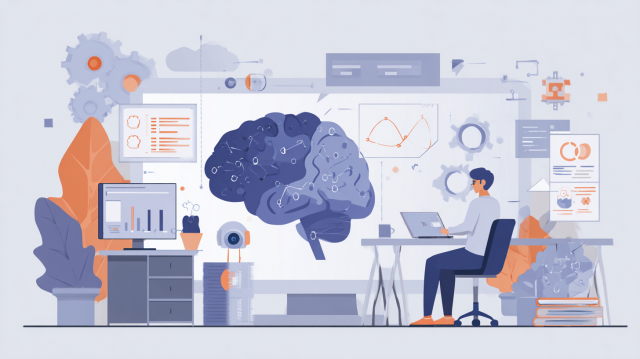
The dream technology represented by ChatGPT allows you to perform various tasks by conversing with machines just like you would with a person. Among these, models known as LLMs (Large Language Models) learn from large-scale language datasets and respond to user questions and prompts in natural language, such as spoken language, with astonishing accuracy. By leveraging their capabilities to handle various tasks such as document generation, summarization, analysis, and code creation, businesses can accelerate operational efficiency, productivity improvement, and value creation. As a result, many companies are advancing their efforts to utilize LLMs. In this article, we will clearly explain how to effectively utilize LLMs in business, using case studies as examples.
- Table of Contents
1. What is LLM?
LLM stands for "Large Language Model." This model demonstrates excellent capabilities in various natural language processing tasks by learning from a vast amount of text data, such as content from the internet. Examples include ChatGPT and Gemini.
LLMs are based on neural networks and excel at considering the context of the input text to predict the subsequent words or phrases. For example, if you input something like, "Briefly tell me about the history of AI*Figure 1," it can gather words related to the history of AI based on its training and output a sentence constructed in a natural order. This mechanism allows for various applications, including text generation, translation, summarization, and analysis.

Figure 1 (Output from GPT-4o)
By applying this capability, it will be possible to utilize various documents that are generated daily in business, such as email and content creation tasks, as well as various reports and meeting minutes that are dispersed and accumulated within the company as knowledge. In the next chapter, we will introduce examples of business applications using LLM.
2. Examples of Use in Business
●Chatbot
Before LLM, there were chatbots that utilized AI, but they were designed to operate based on pre-defined scenarios and rules, making it difficult to respond flexibly to a wide range of customer inquiries. With LLM, it becomes possible to understand various questions. Additionally, it can comprehend free-form text, such as conversational language, and texts that may contain minor typos. Furthermore, LLM can understand chat history and engage in dialogue, allowing it to answer complex questions that are difficult to address in a simple Q&A format. By applying this, it is also possible to customize responses for each user by referencing their individual past inquiries, which was challenging for traditional chatbots.
By utilizing LLM in this way, it becomes possible to respond broadly to various questions and inquiries from customers, which is expected to enhance user experience and satisfaction. Additionally, it is anticipated that the burden on the support team will be significantly reduced.
●Knowledge Management
Knowledge management is the process of effectively collecting, sharing, and utilizing knowledge within a company. This allows the unique experiences and skills of individual employees to spread throughout the organization, leading to increased productivity and the promotion of value creation. Much of this knowledge is accumulated within the company in various text-based documents. However, efficiently utilizing these vast amounts of documents is not an easy task. To extract what information is contained in the documents, one must take the time to open, read, and summarize them. Doing this for a large volume of documents often requires a significant amount of resources, making it impractical in many cases.
LLMs excel at automatically analyzing large volumes of documents and reports, extracting and classifying highly relevant information. Even with vast amounts of documentation, they can automatically organize and utilize the knowledge buried within, making them a powerful tool for streamlining knowledge management.
Reference URL: Takenaka Corporation, Construction Industry Knowledge Search "Digital Master Carpenter" Built with AI "Amazon Bedrock"
●Marketing and Market Research
The data held by companies contains important insights hidden in customer feedback received through surveys and customer support, as well as sales reports that capture market trends. By leveraging the text comprehension and analytical capabilities of LLMs, businesses can utilize this information for their strategies. For example, text analysis of customer reviews and feedback can help understand customer emotions and trends, aiding in the improvement of product development and marketing strategies.
Reference URL: NEC develops technology for planning marketing strategies using generative AI
3. Summary
We have introduced examples of utilizing LLM in business up to this point. Within companies, there is likely a large amount of text data that has either been unused or has not been utilized due to a lack of means to do so. As we have introduced, by leveraging LLM for this data, we can expect further operational efficiency, productivity improvement, and value creation in business. However, simply implementing LLM and feeding it text data does not guarantee immediate results. While LLM can indeed demonstrate excellent capabilities, if you require the level of accuracy needed in business, it may be necessary to organize the data.
This is because regular text data is mostly unstructured data that does not have a certain set of rules or structure. LLMs excel at handling unstructured data, but there are challenges such as hallucinations (the generation of false information that does not correspond to facts) in terms of accuracy. Therefore, to utilize LLMs, it is necessary to structure unstructured data. In most cases, this work needs to be done manually, and if a company handles a vast amount of data on its own, it may hinder its core business. There are many experienced outsourcing vendors for creating structured data, so it is recommended to consider consulting these outsourcing vendors while advancing the implementation of LLMs.
4. Human Science Annotation, LLM RAG Data Outsourcing Service
Over 48 million pieces of training data created
At Human Science, we are involved in AI model development projects across various industries, starting with natural language processing and extending to medical support, automotive, IT, manufacturing, and construction, just to name a few. Through direct business with many companies, including GAFAM, we have provided over 48 million pieces of high-quality training data. No matter the industry, our team of 150 annotators is prepared to accommodate various types of annotation, data labeling, and data structuring, from small-scale projects to big long-term projects.
Resource management without crowdsourcing
At Human Science, we do not use crowdsourcing. Instead, projects are handled by personnel who are contracted with us directly. Based on a solid understanding of each member's practical experience and their evaluations from previous projects, we form teams that can deliver maximum performance.
Support for not just annotation, but the creation and structuring of generative AI LLM datasets
In addition to labeling for data organization and annotation for identification-based AI systems, Human Science also supports the structuring of document data for generative AI and LLM RAG construction. Since our founding, our primary business has been in manual production, and we can leverage our deep knowledge of various document structures to provide you with optimal solutions.
Secure room available on-site
Within our Shinjuku office at Human Science, we have secure rooms that meet ISMS standards. Therefore, we can guarantee security, even for projects that include highly confidential data. We consider the preservation of confidentiality to be extremely important for all projects. When working remotely as well, our information security management system has received high praise from clients, because not only do we implement hardware measures, we continuously provide security training to our personnel.

 Text Annotation
Text Annotation Audio Annotation
Audio Annotation Image & Video Annotation
Image & Video Annotation Generative AI, LLM, RAG Data Structuring
Generative AI, LLM, RAG Data Structuring
 AI Model Development
AI Model Development In-House Support
In-House Support For the medical industry
For the medical industry For the automotive industry
For the automotive industry For the IT industry
For the IT industry




























































































